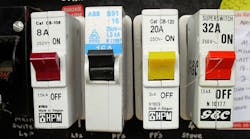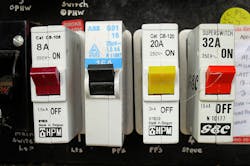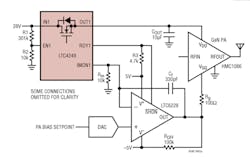The classic circuit breaker—a resettable overcurrent cutoff device—has been with us since the 1920s and is well-known for its reliable, consistent performance and a simple schematic symbol (Fig. 1). Whether the breaker is designed to be activated by current overload as detected by thermal or electromagnetic conditions (both are used), it’s tightly focused by design objective and subsequent implementation on doing one thing and doing it well. (Of course, there are other circuit- and overcurrent-protection devices beyond circuit breakers and fuses, but that’s another story.)
But while such single-minded focus is a good thing, it also can be limiting in in terms of system-design flexibility and versatility. That’s where an electronic circuit breaker (ECB) such as Analog Devices’ LTC4249 provides additional capabilities (Fig. 2). This dual ECB offers features, functions, and flexibility not available with a conventional circuit breaker.
Due to its relatively high voltage rating along with a 1.2-A current rating, it’s able to deliver current oversight and protection across a wide range of applications, including protection for power-amplifier arrays, industrial safety, equipment-condition monitoring, relay replacement, and load switching.
The LTC4249 dual ECB provides independent overcurrent protection to a pair of loads. Each channel has a precision enable input, current-monitor output, and ready status output, with a single resistor to configure the ECB threshold. If an overcurrent condition is detected on either channel, the corresponding breaker disconnects the input from the load.
Note that in some ways, the relationship between a conventional circuit breaker and the ECB is analogous to the one between a conventional fusible-link device (fuse) and an electronic fuse (eFuse). In each case, the former has a single-minded functionality but lacks flexibility—which can be good or bad, depending on your perspective—while the latter is more complicated but brings added features, functions, and options to the designer and circuit approach.
After any circuit-breaker “event,” the open-drain RDY status output pulls low and the ECB latches into the off state. By toggling the enable input, the user can turn the ECB back on after a one-second cool- off period. The cool-off timer, overtemperature sensor, short-circuit detector, and inrush controller prevent operation outside the safe operating area of the circuit breakers.
The LTC4249’s precision enable inputs, ready outputs, and analog current-monitor outputs ease implementation of voltage sequencing and closed-loop-bias current-control applications. Other key specifications include 5% accurate analog current-monitor outputs, filtered (50 μs) primary overcurrent threshold, fast (2 μs) secondary overcurrent threshold, and integrated 75-mΩ switches.
Furthermore, the ECB channels can be used in parallel if needed. Load isolation and reverse-current detection applications are also possible. The 22-page datasheet provides basic information as well as schematic diagrams and descriptions for a variety of application circuits and configurations to ease adoption of this ECB.
The LTC4249, rated for −40 to +125°C operation, is priced at $2.39 (1,000 pieces). It’s housed in a 16-lead, 3- × 3-mm LQFN package. For applications that must meet creepage and clearance standards up to 65 V, a 12-lead “skipped lead” 3- × 4-mm LQFN package also is available.



